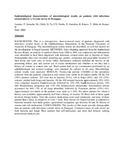Epidemiological characteristics of microbiological results on patients with infectious corneal ulcers: a 13-year survey in Paraguay.

View/
Date
2004Author
Laspina, F
Samudio, M
Cibils, D
Ta, CN
Fariña, N
Sanabria, R
Klauss, V
Miño de Kaspar, H
Type
ArticleLanguage
enMetadata
Show full item recordAbstract
BACKGROUND:
This is a retrospective, chart-reviewed study of patients diagnosed with infectious corneal ulcers at the Ophthalmology Department of the National University of Asunción in Paraguay. The microbiological culture results are described, as well risk factors for the development of fungal keratitis.
METHODS:
After obtaining approval from the Institutional Review Board, an analysis of medical charts from 1988 to 2001 was conducted and 660 patients were identified to have been diagnosed with infectious corneal ulcers due to bacteria or fungi. Demographic data were recorded, including age, gender, occupation and geographic location of their home and work (city or rural). Other information collected included the history of the presenting illness, past and current use of ocular medications and whether or not they had a history of trauma or contact lens use. Each patient had an eye examination performed by an ophthalmologist and corneal scrapings were obtained for cultures in all cases. Microbiologic culture results were analyzed.
RESULTS:
Twenty-one percent (136/660) of the specimens collected from the patients' conjunctiva and cornea were sterile in all culture media. Of the 524 (79%) positive cultures, 267 were due to bacteria (51%), 136 to fungi (26%), and 121 (23%) cultures yielded both fungi and bacteria. Of the 430 isolated bacteria approximately 25% (103) were coagulase negative Staphylococcus, followed by 23% (94) Staphylococcus aureus, 14% (60) Pseudomonas aeruginosa and 13% (56) Streptococcus pneumoniae. Acremonium species accounted for 40% (79) of all fungi identified, followed by Fusarium species (15%) (41). Approximately two-thirds of the patients were male (n = 435). For those patients for whom a history was available, approximately half had a history of trauma. Of these, half of these again involved foreign bodies. Over-the-counter medications were used commonly, and most of those patients had a delay in diagnosis of over 1 week. Risk factors for fungal keratitis as opposed to bacterial keratitis were male gender, agricultural occupation, age between 30 and 59, history of trauma and self-medication.
CONCLUSIONS:
The results of this study provide demographic data on patients with infectious corneal ulcers in Paraguay. Common causes of such ulcers are both bacteria and fungi. Most patients had self-medicated, and most had delayed seeking professional medical care.
URI
http://hinari-gw.who.int/whalecomwww.ncbi.nlm.nih.gov/whalecom0/pubmed/14760489http://erepository.uonbi.ac.ke:8080/xmlui/handle/123456789/35544
Citation
Graefes Arch Clin Exp Ophthalmol. 2004 Mar;242(3):204-9. Epub 2004 Feb 4.Publisher
Research Institute of Health-Science (IICS), National University of Asunción, Asunción, Paraguay
Collections
- Faculty of Health Sciences (FHS) [10415]
- Theses & Dissertations [241]
